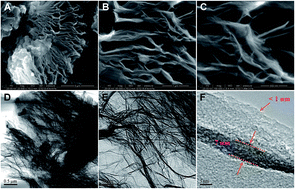Controlled synthesis of three-dimensional interconnected graphene-like nanosheets from graphite microspheres as high-performance anodes for lithium-ion batteries†
Abstract
Three-dimensional (3D) graphene-based materials have received increasing attention due to their application potential in electrochemical energy storage and conversion. Herein, we demonstrate a facile and efficient strategy to synthesize 3D interconnected graphene-like nanosheets (3DGNs) directly developed from graphite microspheres. The graphene-like nanosheets are interwoven into a unique 3D macroporous network architecture, which can prevent the graphene nanosheets from aggregating effectively. When used as an anode in lithium ion batteries, the 3DGN architecture is capable of reaching an extremely high reversible discharge capacity of 2795.6 mA h g−1, while maintaining a good electrochemical stability with a very high capacity of 1708.5 mA h g−1 after 120 cycles. The superior electrochemical performances of the 3DGN architecture may be attributed to its unique structural features, such as efficient ion/electron conductive channels of 3D interconnected nanosheets, enhanced specific surface area as well as its favorable surface structural features.


 Please wait while we load your content...
Please wait while we load your content...